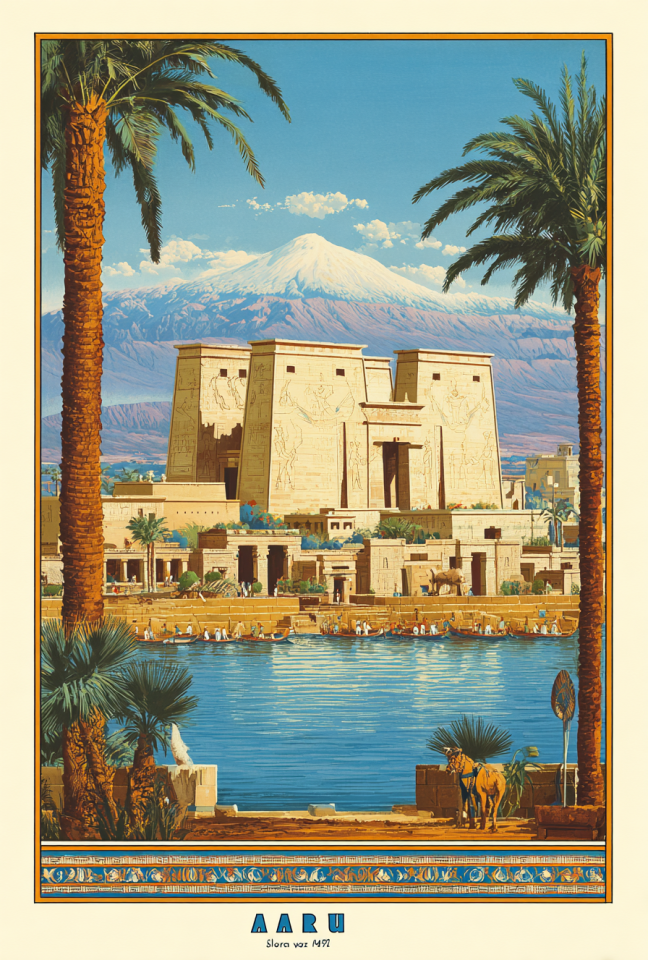Aaru, the Field of Reeds, is the eternal realm of peace, abundance, and divine rhythm — the perfected reflection of the Nile’s bounty and the sacred destination of souls who have lived in accordance with Ma’at. Yet it is more than just paradise. Aaru also serves as the rare place of **divine convergence**, where gods of ancient Egypt — though scattered across their own domains — may assemble to align on matters of great cosmic weight. It is a living realm of cyclical rebirth, moral clarity, and sacred agriculture, where order is not enforced, but *embodied*. Once glimpsed in funerary rites and carried in hieroglyphic dream, Aaru is now sealed behind the Veil, its paths accessible only to the balanced heart and the will of the gods.
Landscape and Essence
Aaru stretches in endless green plains, bound by lotus-dappled canals and swaying papyrus. It mirrors the Nile at its most serene — a paradise of perfect planting and perpetual harvest. The sun never burns, but glows gently; the waters never flood, but nourish with ideal precision. The realm is structured in **forty-two districts**, each watched over by a guardian spirit, reflecting both unity and multiplicity in divine order. Fields extend without horizon, but each soul finds its proper place, and no labor is burdensome. The air is rich with myrrh and water vapor, and time does not progress — it *cycles*, like the rising and setting of Ra’s barque through the layered cosmos.
Inhabitants
Aaru is home to the *akh* — righteous spirits who passed the Weighing of the Heart and entered into eternal harmony. They till and reap not in toil, but in sacred rhythm, fulfilling the ideal life unbroken by mortality. These spirits retain identity, yet glow with refinement — their forms luminous and serene. Presiding over this blessed domain is **Osiris**, Lord of the Afterlife, seated in radiant judgment beneath a canopy of stars. Other deities move through Aaru as guides, observers, and occasionally, as conveners: **Isis**, **Thoth**, **Horus**, and even **Ra** walk its banks when great workings are called. Aaru is thus both sanctuary and sacred table — a realm of peace that hosts divine congress.
Cultural Significance
To the people of ancient Kemet, Aaru was no abstraction. It was a real place promised to those who upheld Ma’at — the sacred law of balance, truth, and right action. Funerary texts, tomb carvings, and ritual recitations were designed to guide the soul through the perils of Duat and into Aaru’s green fields. Grain offerings, images of plows, and boat models placed with the dead were not symbols — they were *tools* meant to function once the gates were passed. The idea of paradise was never passive: to live eternally in Aaru was to remain active, in harmony, and *aligned*. When outside forces broke these traditions, and tombs were emptied of meaning, the gateways to Aaru faded — yet its memory remains embedded in Nile soil and star-path.
Role in the Divine Realm
Aaru serves a dual function: as paradise for the justified dead and as **neutral meeting ground** for the Netjeru — the gods of Kemet. Unlike Olympus or Mount Lel, Aaru is not ruled by intrigue or decree, but by **consensus and presence**. When divine matters affecting multiple domains arise — matters of rebirth, cosmic transition, or rebalancing after disorder — the gods may gather here in sacred stillness. Osiris presides, not as king, but as stabilizing center. Thus, Aaru is both endpoint and council chamber — the place where divine wisdom and moral consequence are never separate.
Interactions with Other Realms
Aaru was once accessed through the Duat, after a soul passed judgment before Osiris and the 42 Assessors. Some pharaohs and high priests were said to travel there briefly in ritual vision, to commune with the divine or to witness the order of the afterlife. Temples aligned their architecture to its imagined geometry, and sacred rites mirrored the fields of Aaru through offerings and chants. As balance eroded and foreign dominions seized the rites of death, the passageways narrowed. The Veil now lies thick over the river of stars, and only the most perfected dead — or gods with sanctioned purpose — may cross. Still, its influence touches every realm that values truth over illusion, and balance over force.
















